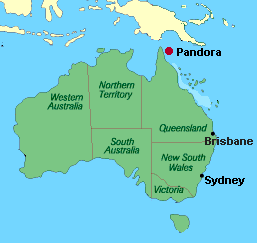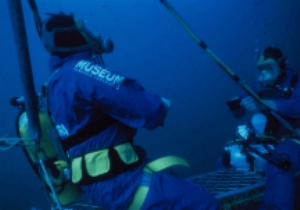
Map 1: Map of Australia showing location of the wreck of the Pandora
Image used courtesy of the Queensland Museum
In 1787 the British Government appointed Lieutenant William Bligh to command the ship HMS Bounty, with the aim of collecting and transporting breadfruit from the Pacific Islands. After spending some five months at Tahiti, and successfully collecting the breadfruit plants, Bligh set sail for home. Less than a month later the famous mutiny, led by Fletcher Christian, occurred where Bligh and 18 crew members were cast adrift in a 7m longboat. Bligh sailed back to England to report the incident after which the British government promptly commissioned the 24-gun frigate HMS Pandora to search the Pacific and bring the Bounty mutineers to justice.
After capturing 14 mutineers at Tahiti, the Pandora gave up further search and set sail for Timor via the Torres Straits. While negotiating the Great Barrier Reef for a safe passage, the Pandora struck a submerged outcrop of reef which resulted in her sinking. 31 crew and 4 mutineers lost their lives.

Map 1: Map of Australia showing location of the wreck of the Pandora
Image used courtesy of the Queensland Museum
The wreck of the Pandora was rediscovered in 1977 and placed under the Historic Shipwreck Act (1976), and the care of Queensland Museum archaeologists. Since 1983, systematic excavation has been carried out and in 1986 resulted in the emotive discovery of human skeletal remains. Wood and Hodgson (1996) performed a forensic investigation on the 1986 material, confirming it belonged to a human male. During the excavation seasons of 1995 through to 1998, more than 200 human bones and bone fragments have been uncovered. The 1986 individual described by Wood and Hodgson (1996) is thought to belong to one of the individuals represented by the more recently discovered, and somewhat larger, collection of skeletal material. Clearly, people had been trapped within the confines of the ship when it sank, raising questions such as who these individuals were and why were their bodies had not been recovered from the wreck.

Figure 1:Queensland Museum Divers slowly ascending from an excavation session
Osteological analysis confirmed the number of individuals present as three males, who were most likely Caucasian. For ease of reference, the three skeletons were named Tom, Dick and Harry. Forensic analysis of Tom, Dick and Harry estimated their ages at approximately 17, 22 and 28 years respectively. Their antemortem heights were estimated at 168+/-4cm, 165+/-6cm and 166+/-4cm respectively. Other evidence on the skeletons suggested the presence of chronic diseases such as rickets and syphilis. One individual demonstrated the presence of spina bifida (MA6418-3, MA6418-2) early in life. Other signs of pathology were also evident, and in addition all showed poor dental hygiene.
After some 200 years of submersion in a marine environment, unique taphonomic effects were seen to affect the remains. Description of these processes provide important forensic information on the nature of bone remains in this type of environment. In spite of comparisons with historical accounts of the wrecking and descriptions of the 35 men lost, the individuals could not be identified. In addition, the cause of death remained undetermined.
Included in this article are descriptions of each individual, the forensic techniques employed and a critical historical analysis of the remains. This investigation has attempted to shed some light on a fascinating aspect of the wreck of the Pandora and the Bounty saga. It is hoped that the identity of the three men recovered from the wreck may be better understood as a result of this study. At the time of publication, DNA studies have begun in an effort to identify the skeletons through reverse-genealogy.
This article begins with a review of the historical accounts of the wrecking of the Pandora. If you want to skip to this, you may go straight to the section on the rediscovery of the Pandora wreck or to the study of the human remains which forms the focus of this article.
© Internet Archaeology
URL: http://intarch.ac.uk/journal/issue11/4/2.html
Last updated: Thu Mar 28 2002